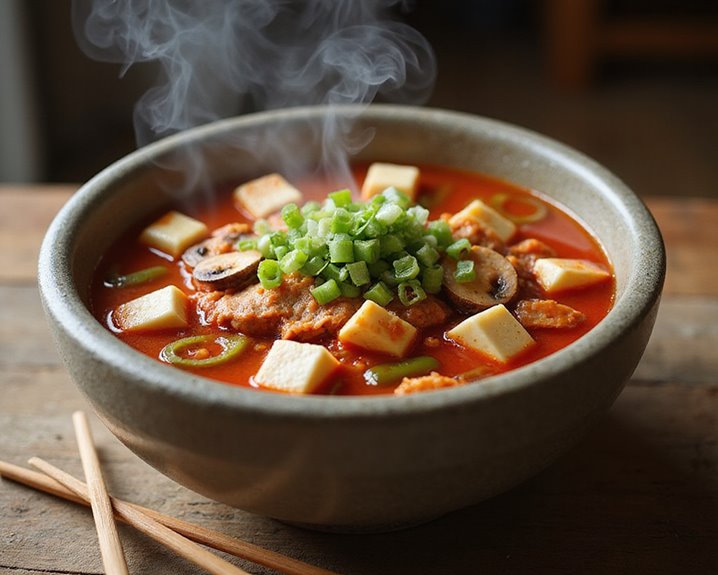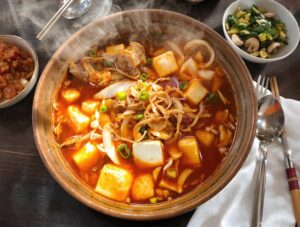Why You’ll Love this Korean Kimchi Jjigae Soup
When the weather turns chilly, nothing warms you up quite like a steaming bowl of Kimchi Jjigae. This iconic Korean soup strikes the perfect balance between spicy, savory, and slightly sour flavors—a combination that keeps you coming back for more. Trust me, the aromatic blend of fermented kimchi, rich broth, and tender pork creates a depth of flavor that’s simply irresistible.
What makes this soup so special? Perhaps it’s how the tangy kimchi mellows as it simmers, or maybe it’s the way the tofu soaks up all those incredible seasonings. The beauty of Kimchi Jjigae is its versatility. Don’t eat meat? Skip the pork. Want it extra spicy? Add more gochugaru. Craving something substantial but not heavy? This soup hits that sweet spot.
What Ingredients are in Korean Kimchi Jjigae Soup?
Korean Kimchi Jjigae is a fiery, soul-warming soup that’s become beloved far beyond Korea’s borders. This hearty stew combines the tangy, fermented punch of sour kimchi with savory ingredients that create a complex flavor profile. The beauty of this dish lies in its balance – spicy, sour, and savory notes all dancing together in perfect harmony.
Let’s break down exactly what you’ll need to create this comforting Korean classic in your own kitchen.
- 1/8 pound pork loin (optional – omit for vegetarian version)
- 1 tablespoon rice wine (for marinating the pork)
- 1 cup sour kimchi, cut into 1-inch pieces (reserve the juice)
- 1/4 white onion, sliced
- 1 green onion, sliced
- 1/4 cup mushrooms (regular or shiitake)
- 3 tablespoons sliced Anaheim green chili peppers
- 1 cup extra-firm tofu, cut into 1/4-inch slices
- 1 1/2 cups water
- Vegetable oil for cooking
- 4 teaspoons Korean chili flakes (gochugaru)
- 2 teaspoons Korean chili paste (gochujang)
- 4 teaspoons soy sauce
- 1/2 teaspoon minced garlic (fresh or bottled, not dried)
- Black pepper to taste
When shopping for these ingredients, the quality of your kimchi matters tremendously—older, more sour kimchi actually works best for this soup, giving it that characteristic tangy depth. The Korean chili products (gochugaru and gochujang) are worth seeking out at Asian markets or online, as they provide an authentic flavor that generic red pepper substitutes just can’t match. And while the pork adds a lovely richness, vegetarians can simply skip it without sacrificing too much of the dish’s soul. The tofu soaks up all those wonderful flavors, making it an essential component regardless of whether you include meat.
How to Make this Korean Kimchi Jjigae Soup

Start by prepping all your ingredients—this makes the cooking process so much smoother. Cut 1 cup of sour kimchi into 1×1 inch pieces (don’t forget to save that flavorful juice), slice 1/4 white onion, chop 1 green onion, prepare 1/4 cup of mushrooms, and slice 3 tablespoons of Anaheim green chili peppers. Cut 1 cup of extra firm tofu into 1/4-inch slices and set aside. If you’re using pork, rinse 1/8 pound of pork loin, cut it into thin strips, and marinate it in 1 tablespoon of rice wine with a couple pinches of black pepper for about 15 minutes. The marinade infuses the meat with flavor that will later blend beautifully with the spicy broth.
While the meat marinates, heat some vegetable oil in a pan and cook the kimchi over medium-high heat for 5-7 minutes, stirring frequently. You’ll know the kimchi is ready when it turns slightly translucent. This step is pivotal—cooking the kimchi before adding it to the soup helps to mellow its raw pungency and develop a deeper flavor profile. For authentic Asian cooking results, consider using a Sichuan wok cooking set which distributes heat evenly and allows for better flavor development. The distinctive aroma that fills your kitchen at this point is one of the most satisfying parts of making kimchi jjigae, a true sign that something delicious is in the works.
The recipe seems to be cut off in the instructions, but typically you’d continue by combining the cooked kimchi with the marinated meat and other ingredients in a pot, adding 1 1/2 cups of water and the seasonings (4 teaspoons Korean chili flakes, 2 teaspoons Korean chili paste, 4 teaspoons soy sauce, and 1/2 teaspoon minced garlic). Bring everything to a boil, then reduce to a simmer until the meat is cooked through and the flavors have melded together. Add the tofu toward the end of cooking so it warms through but doesn’t break apart. This hearty, warming soup is perfect for chilly evenings, and the robust flavors of the fermented kimchi make it a true Korean comfort food classic.
Korean Kimchi Jjigae Soup Substitutions and Variations
The beauty of Kimchi Jjigae lies in its flexibility, allowing for numerous substitutions and variations to suit your taste preferences or ingredient availability. Don’t have pork loin? Swap it for beef, chicken, or even spam—a surprisingly delicious option. For a seafood twist, try adding shrimp or chunks of white fish.
Vegetarians can simply omit the meat and double up on mushrooms—shiitakes add wonderful umami depth. Can’t handle the heat? Reduce the gochugaru (Korean chili flakes) or balance with a touch more tofu. Need it spicier? Add a dab more gochujang or throw in some fresh jalapeños.
For a heartier meal, toss in some cooked ramen noodles just before serving. Who knew one soup could wear so many delicious hats?
What to Serve with Korean Kimchi Jjigae Soup
Now that we’ve explored the many faces of Kimchi Jjigae, let’s talk about creating the perfect meal around this spicy, soul-warming soup.
Rice is the non-negotiable companion here. A bowl of fluffy white rice soaks up that fiery broth beautifully, creating the perfect balance with each spoonful.
I always set out banchan (small side dishes) like cucumber kimchi, spinach namul, or bean sprouts for textural contrast. Want to round things out? Add a simple protein like pan-fried mackerel or bulgogi.
For drinks, cold barley tea cuts through the heat, while beer lovers might appreciate how a light lager complements the spice. And don’t forget those metal chopsticks and a long-handled spoon—essential tools for maneuvering this steaming, bubbling pot of comfort. Hungry yet?
Final Thoughts
After exploring this traditional Korean dish from every angle, I’m convinced that Kimchi Jjigae isn’t just soup—it’s a cultural institution in a bowl. The way the fermented kimchi mingles with the savory broth creates something truly magical, warming both body and soul.
What I love most about this recipe is its adaptability. Don’t eat pork? Skip it or substitute tofu. Want it spicier? Add more gochugaru. Need a quick weeknight dinner? Use pre-made broth to speed things up.

